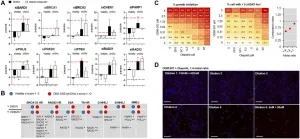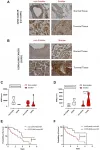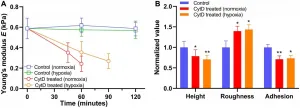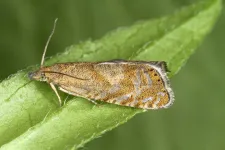(Press-News.org) Why do alterations of certain genes cause cancer only in specific organs of the human body? Scientists at the German Cancer Consortium (DKTK), the Technical University of Munich (TUM), and the University Medical Center Göttingen have now demonstrated that cells originating from different organs are differentially susceptible to activating mutations in cancer drivers: The same mutation in precursor cells of the pancreas or the bile duct leads to fundamental different outcomes. The team discovered for the first time that tissue specific genetic interactions are responsible for the differential susceptibility of the biliary and the pancreatic epithelium towards transformation by oncogenes. The new findings could guide more precise therapeutic decision making in the future.
There have been no major improvements in the treatment of pancreatic and biliary tract cancer in the last decades and no effective targeted therapies are available to date. "The situation for patients with pancreatic and extrahepatic bile duct cancer is still very depressing with approximately only 10% of patients surviving five years," says Dieter Saur, DKTK Professor for Translational Cancer Research at TUM's university hospital Klinikum rechts der Isar, DKTK partner site Munich.
DKTK is a consortium centered around the German Cancer Research Center (DKFZ) in Heidelberg, which has long-term collaborative partnerships with specialist oncological centers at universities across Germany.
"To discover novel therapeutic strategies that improve prognosis of these patients, it is essential to understand the fundamental genetic networks and interactions that drive these tumors in a tissue-specific fashion. This will allow highly precise molecular interventions in future."
The research team looked at the development of biliary tract and pancreatic cancer in mice, replacing the normal "oncogenes" PIK3CA and KRAS with a version containing a mutation identical with that in human cancers. Expression of these oncogenes in the common precursor cells of the extrahepatic bile duct and the pancreas led to very different outcomes. Mice with the mutated PI3K gene developed mostly biliary tract cancer, mice with the mutated KRAS gene instead developed exclusively pancreatic cancer.
This was unexpected because both genes are mutated in both human cancer types. Subsequent analyses discovered the fundamental genetic processes underlying the differential sensitivity of the different tissue types towards oncogenic transformation.
"Our results are an important step toward solving one of the biggest mysteries in oncology: Why do alterations of certain genes cause cancer only in specific organs?" says Chiara Falcomatà the first author of the new publication. "Our studies in mice revealed how genes co-operate to cause cancer in different organs. We identified main players, the order in which they occur during tumor progression, and the molecular processes how they turn normal cells into threatening cancers. Such processes are potential targets for new treatments".
In the mice, the team uncovered a stepwise process of genetic alterations, which drive the development of these cancer types. Some cooperating genetic events overactivate the PI3K signaling pathway, making them cancerous. Others disrupt regulators proteins, inactivating their ability to suppress cancer progression.
"Understanding the genetic interactions in different cancer types will guide more precise therapeutic decision making in the future" says Günter Schneider, Professor for Translational Cancer Research at the University Medical Center Göttingen. "Our ability to engineer specific genetic alterations in mice allows us to study the function of cancer genes and to model specific cancer subtypes. Such mouse models are also invaluable for testing anticancer drugs before using them in clinical trials".
"What we showed is that the function of an oncogene is different depending on the tissue type and what other genes are altered," says Roland Rad Professor at TUM and a DKTK researcher. "These oncogenes need to hijack the intrinsic signaling network of a specific tissue to allow cancer development. Interestingly, such networks exist only in specific tissue types making them susceptible for cancer development."
These findings have important implications for therapeutic interventions. "The concept that multiple tissue-specific genetic interactions drive cancer progression demonstrates that no single gene can predict responsiveness of a cancer to a particular therapy," says Saur. "In future, it is key to mechanistically understand the tissue specific determinants of therapeutic response and resistance to get precision medicine to the next level."
Several of the authors including Dieter Saur and Roland Rad are based at TranslaTUM, TUM's Center for Translational Cancer Research. In this interdisciplinary research institute, doctors work with colleagues from the fields of natural sciences and engineering on research into causes, diagnostics and potential treatments of cancerous diseases.
INFORMATION:
Chiara Falcomatà, Stefanie Bärthel, Angelika Ulrich, Sandra Diersch, Christian Veltkamp, Lena Rad, Fabio Boniolo, Myriam Solar, Katja Steiger, Barbara Seidler, Magdalena Zukowska, Joanna Madej, Mingsong Wang, Rupert Öllinger, Roman Maresch, Maxim Barenboim, Stefan Eser, Markus Tschurtschenthaler, Arianeb Mehrabi, Stephanie Roessler, Benjamin Goeppert, Alexander Kind, Angelika Schnieke, Maria S. Robles, Allan Bradley, Roland M. Schmid, Marc Schmidt-Supprian, Maximilian Reichert, Wilko Weichert, Owen J. Sansom, Jennifer P. Morton, Roland Rad, Günter Schneider, Dieter Saur: Genetic screens identify a context-specific PI3K/p27Kip1 node driving extrahepatic biliary cancer
Cancer Discovery 2021, DOI: 10.1158/2159-8290.CD-21-0209
A picture is available for download:
http://www.dkfz.de/de/presse/pressemitteilungen/2021/bilder/PDAC2.jpg
Caption: Pancreatic Cancer, induced by activation of the PIK3CA oncogene
Source: T. Santos/DKTK & TUM
In the German Cancer Consortium (DKTK), the German Cancer Research Center (DKFZ) joins up with university hospitals all over Germany. Assembled around a core at the DKFZ in Heidelberg, the consortium unites twenty high-ranked institutes from seven partner sites: Berlin, Dresden, Essen/Dusseldorf, Frankfurt/Mainz, Freiburg, Munich and Tubingen, all specialized in research and treatment focused on oncological diseases. The DKTK was found to promote translational research, bringing together scientists, physicians and associates to work jointly toward the main goal of enhancing the translation of research from bench to bedside. New approaches in prevention, diagnostics and treatment will be applied to cancer in common translational centers at all partner sites. Patients will be recruited at all partner sites for innovative studies to be carried out by the consortium as a whole. All the data from this work will be collected in a universal system. The harmonization of techniques and methods used in laboratories will ensure identical standards for all researchers and physicians in the consortium. A joint infrastructure will make them available for communal research. With the school of oncology, the consortium is additionally dedicating itself to the education of new physicians and scientists. Talented young people will be trained in cancer medicine and translational cancer research in a common effort involving all members. The German Cancer Consortium is a joint initiative of the Federal Ministry of Education and Research, the participating German states, German Cancer Aid and the German Cancer Research Center. It is one of the six German Centers for Health Research (DZG).
The climate crisis will lead to changes in distribution and habitat loss of stony corals in the tropical Atlantic, shows a new study published by the open access publisher Frontiers. The loss of such coral species could have devastating consequences for the marine ecosystems they inhabit. The results of the study highlight an urgent need for coral reef management in the Atlantic.
Researchers at the University of São Paulo projected current and future distributions of three key reef building corals of the tropical Atlantic (Mussismilia hispida, Montastraea cavernosa and the Siderastrea complex). They ...
To prepare for the next pandemic and provide a coordinated approach to vaccination across the country, Canada should create Canadian Immunization Services based on the Canadian Blood Services model, authors propose in CMAJ (Canadian Medical Association Journal).
The authors, including a leading health policy and immunization expert, a blood system expert and a former federal minister of health, are Dr. Kumanan Wilson, professor, Department of Medicine and member of the Centre for Health Law, Policy and Ethics, University of Ottawa; Dr. Graham Sher, CEO, Canadian Blood Services; and Dr. Jane Philpott, Dean, Faculty of Health Sciences, Queen's University.
"If we want to be better prepared for the ...
Philadelphia, July 19, 2021 - University of Minnesota School of Public Health researchers recently completed a study to determine how food-insecure young (emerging) adults (18-29 years of age) adapted their eating and child feeding behaviors during the COVID-19 pandemic. The researchers also sought to identify barriers to food access and opportunities to improve local access to resources for emerging adults. Their END ...
Oncotarget published "Ex vivo analysis of DNA repair targeting in extreme rare cutaneous apocrine sweat gland carcinoma" which reported a rare metastatic case with a PALB2 aberration identified previously as a familial susceptibility gene for breast cancer in the Finnish population.
As PALB2 exhibits functions in the BRCA1/2-RAD51-dependent homologous DNA recombination repair pathway, we sought to use ex vivo functional screening to explore sensitivity of the tumor cells to therapeutic targeting of DNA repair.
Drug screening suggested sensitivity of the PALB2 deficient cells to BET-bromodomain inhibition, and modest ...
Oncotarget published "Caspase-11 and AIM2 inflammasome are involved in smoking-induced COPD and lung adenocarcinoma" which reported that cigarette smoking is the leading risk factor for COPD and lung cancer establishment.
Epidemiologically, COPD patients are 6.35 times more likely to develop lung cancer.
To mimic COPD, the authors exposed mice to nose-only cigarette smoke and used human samples of lung adenocarcinoma patients according to the smoking and COPD status.
Interestingly, higher expression of AIM2 in non-cancerous tissue of smoking COPD adenocarcinoma patients was correlated to a higher hazard ratio of poor survival ...
Oncotarget published "Dynamic cellular biomechanics in responses to chemotherapeutic drug in hypoxia probed by atomic force spectroscopy" which reported that by exploiting single-cell, force spectroscopy methods, the authors probed biophysical and biomechanical kinetics of brain, breast, prostate, and pancreatic cancer cells with standard chemotherapeutic drugs in normoxia and hypoxia over 12-24 hours.
After exposure to the drugs, they found that brain, breast, and pancreatic cancer cells became approximately 55-75% less stiff, while prostate cancer cells became more stiff, due to either drug-induced ...
Butterflies and moths (order Lepidoptera) are one of the most diverse animal groups. To date, scientists have found as many as 5,000 species from the Alps alone. Having been a place of intensive research interest for 250 years, it is considered quite a sensation if a previously unknown species is discovered from the mountain range these days. This was the case when a Swiss-Austrian team of researchers described a new species of alpine moth in the open-access, peer-reviewed journal Alpine Entomology, solving a 180-year-old mystery.
Decades of research work
Initially, the team - Jürg Schmid, a full-time dentist, author and passionate butterfly and moth researcher from Switzerland, and Peter Huemer, head of the natural science collections ...
Researchers are using computer models to simulate COVID-19 infections on a cellular level - the basic structural level of the human body.
The models allow for virtual trials of drugs and vaccines, opening the possibility of pre-assessment for drug and vaccine efficacy against the virus.
The research team at the University of Waterloo includes Anita Layton, professor of applied mathematics and Canada 150 Research Chair in mathematical biology and medicine, and Mehrshad Sadria, an applied mathematics PhD student.
The team uses "in silico" experiments to replicate how the human immune system deals with the COVID-19 virus. In silico refers to trials situated in the silicon of computer chips, as opposed to "in ...
PULLMAN, Wash. --Students who identify as LGBTQ+ in Washington state school districts with conservative voting records reported experiencing more bullying than their peers in more politically liberal areas, according to a new study.
For the study in the journal Analyses of Social Issues and Public Policy, researchers explored the relationships among school district voting records in the 2016 presidential election, bullying experiences in schools and mental health outcomes of LGBTQ+ youth in the state.
The study shows LGBTQ+ students are at a higher risk for psychological distress and suicidality as a result of bullying, particularly in school districts that voted for former ...
WHAT:
In a perspective published in Neuropsychopharmacology, leaders from the National Institutes of Health address how using appropriate language to describe mental illness and addiction can help to reduce stigma and improve how people with these conditions are treated in health care settings and throughout society. The authors define stigma as negative attitudes toward people that are based on certain distinguishing characteristics. More than a decade of research has shown that stigma contributes significantly to negative health outcomes and can pose a barrier to seeking treatment for mental ...



